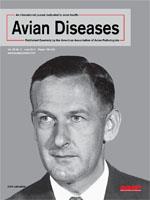Avian pathogenic Escherichia coli (APEC) causes huge annual losses in the poultry industry worldwide. Multiresistance against antibiotics of APEC strains is increasingly seen in broilers, although much is still unknown about strains from laying hens where use of antibiotics is limited. Disinfection can reduce the infection burden. However, little is known about the presence of resistance against these products. Ninety-seven APEC strains were isolated from Belgian laying hens. The resistance to different classes of antibiotics was determined as well as the minimum inhibitory concentrations (MIC; agar and broth dilution) and minimum bactericidal concentrations (MBC) of five disinfectants most often used in the poultry industry (formaldehyde, glutaraldehyde, glyoxal, hydrogen peroxide, and a quaternary ammonium compound). The presence of integrons was determined by PCR. Resistance to ampicillin (35.1%), nalidixic acid (38.1%), sulfonamides (SULFA, 41.2%), and tetracycline (TET, 53.6%) was high but resistance to other tested antibiotics was low. Nevertheless, two extended spectrum beta-lactamase producers were found. The MIC of the disinfectants for the APEC strains showed a Gaussian distribution, indicating that there was no acquired resistance. MBCs were similar to MICs via the broth dilution method, showing the bactericidal effect of the disinfectants. Twenty-one strains (21.6%) were found positive for class 1 integrons and a positive association between integron presence and resistance to trimethoprim, SULFA, and TET was found. No association could be found between integron presence and phylogenetic group affiliation. Susceptibility of APEC strains from laying hens to antibiotics is, in general, very high. Phenotypic resistance to commonly used disinfectants could not be found, indicating that the current use of disinfectants in the laying hen industry did not select for resistance.
Susceptibilidad a los antibióticos, desinfectantes y prevalencia de integrones de Escherichia coli patógena aviar de aves de postura en Bélgica.
La Escherichia coli patógena aviar (con las siglas en inglés APEC) causa enormes pérdidas anuales en la industria avícola de todo el mundo. La resistencia múltiple a los antibióticos por las cepas de E. coli patógenas aviares se observa cada vez más en los pollos de engorde, aunque queda mucho por conocer sobre las cepas de gallinas ponedoras donde el uso de antibióticos es limitado. La desinfección puede reducir la carga de la infección. Sin embargo, poco se sabe acerca de la presencia de resistencia en contra de estos productos. Noventa y siete cepas de E. coli patógenas aviares fueron aisladas de gallinas ponedoras en Bélgica. La resistencia a las diferentes clases de antibióticos se determinó así como las concentraciones mínimas inhibitorias (CMI; con diluciones en agar y en caldo) y las concentraciones mínimas bactericidas (MBC) de cinco desinfectantes que se utilizan más a menudo en la industria avícola (formaldehído, glutaraldehído, glioxal, peróxido de hidrógeno y un compuesto cuaternario de amonio). La presencia de integrones se determinó mediante PCR. La resistencia a la ampicilina (35.1%), ácido nalidíxico (38.1%), sulfonamidas (SULFA, 41.2%) y tetraciclina (TET, 53.6%) fueron altas, pero la resistencia a otros antibióticos analizados fue baja. Sin embargo, se encontraron dos productores de beta-lactamasas de espectro extendido. La concentración mínima inhibitoria de los desinfectantes para las cepas de E. coli patógenas aviares mostró una distribución de Gauss, lo que indica que no había resistencia adquirida. Las concentraciones mínimas bactericidas fueron similares a las concentraciones mínimas inhibitorias a través del método de dilución en caldo, que muestra el efecto bactericida de los desinfectantes. Veintiún cepas (21.6%) resultaron positivas para la clase 1 de integrones y se encontró





